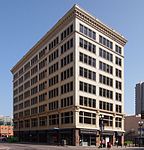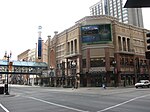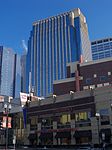First Avenue (nightclub)
1970 establishments in MinnesotaArt Deco architecture in MinnesotaCulture of MinneapolisGreyhound LinesMusic venues in Minnesota ... and 2 more
Nightclubs in the United StatesTourist attractions in Minneapolis

First Avenue & 7th St Entry (locally known as The Mainroom and The Entry) are two music venues housed in the same landmark building in downtown Minneapolis, Minnesota. The names are derived from the building's location on the corner of First Avenue North and 7th Street North. The building is marked by 531 stars on its exterior commemorating past venue performers.David Carr wrote in The New York Times that First Avenue's cultural weight and history is matched by only a few clubs in the United States: CBGB, Maxwell's, Metro Chicago and the 9:30 Club.The nightclub celebrated its 50th anniversary in 2020.
Excerpt from the Wikipedia article First Avenue (nightclub) (License: CC BY-SA 3.0, Authors, Images).First Avenue (nightclub)
North 7th Street, Minneapolis
Geographical coordinates (GPS) Address External links Nearby Places Show on map
Geographical coordinates (GPS)
| Latitude | Longitude |
|---|---|
| N 44.978 ° | E -93.27594 ° |
Address
First Avenue
North 7th Street
55401 Minneapolis
Minnesota, United States
Open on Google Maps









